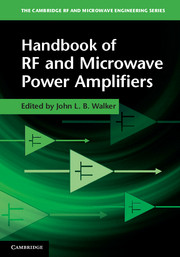Book contents
- Frontmatter
- Contents
- Contributors
- Preface
- 1 Silicon LDMOS and VDMOS transistors
- 2 GaAs FETs – physics, design, and models
- 3 Wide band gap transistors – SiC and GaN – physics, design and models
- 4 Amplifier classes, A to S
- 5 Computer-aided design of power amplifiers
- 6 Practical HF/VHF/UHF RF power amplifier realization
- 7 Microwave hybrid amplifier realization
- 8 Monolithic power amplifiers
- 9 RF power amplifier thermal design
- 10 Reliability
- 11 Power amplifier applications
- 12 Amplifier measurements
- About the authors
- Index
- References
5 - Computer-aided design of power amplifiers
Published online by Cambridge University Press: 05 November 2011
- Frontmatter
- Contents
- Contributors
- Preface
- 1 Silicon LDMOS and VDMOS transistors
- 2 GaAs FETs – physics, design, and models
- 3 Wide band gap transistors – SiC and GaN – physics, design and models
- 4 Amplifier classes, A to S
- 5 Computer-aided design of power amplifiers
- 6 Practical HF/VHF/UHF RF power amplifier realization
- 7 Microwave hybrid amplifier realization
- 8 Monolithic power amplifiers
- 9 RF power amplifier thermal design
- 10 Reliability
- 11 Power amplifier applications
- 12 Amplifier measurements
- About the authors
- Index
- References
Summary
Introduction
In any book about power amplifiers, it seems essential to discuss the most important tool in their design, circuit-analysis software. The development of such software has progressed from improvements in the understanding of linear and, especially, nonlinear circuit theory, as well as rapid improvements in computer and software technology over the past 20 or 30 years. While we all know about these successes, there exists a third dimension to the maturity of circuit-design software: our ability to create and especially to maintain large software systems to support a versatile design flow for a wide variety of RF/microwave components. In spite of these successes, however, circuit-analysis technology has not reached the point where it is perfectly transparent; some “street wisdom” on the part of the user is still required. By describing the underlying technology of these software systems, this chapter should impart some of that wisdom.
Linear analysis
Linear analysis is an important part of any nonlinear circuit simulator; it is also intrinsically useful, as many types of circuit are quite satisfactorily treated as linear. Early linear circuit-analysis software treated all elements as two-ports and connected them in series, parallel, or cascade according to the structure of the circuit. Since most microwave matching circuits can be described easily this way, it was a useful way to create a set of circuit equations.
- Type
- Chapter
- Information
- Handbook of RF and Microwave Power Amplifiers , pp. 188 - 231Publisher: Cambridge University PressPrint publication year: 2011

